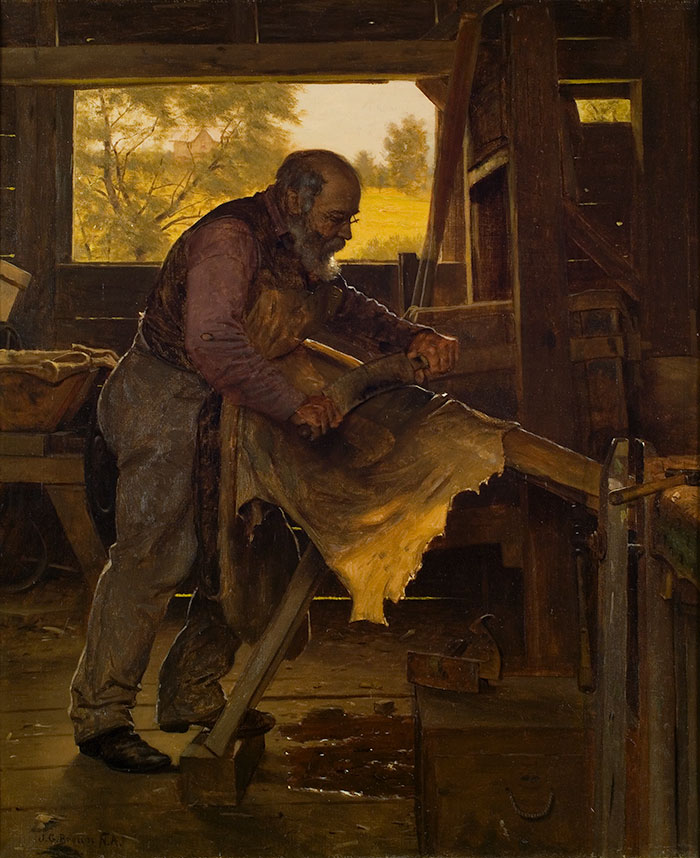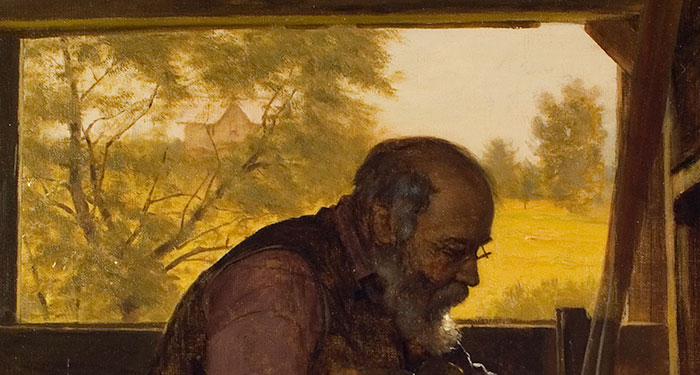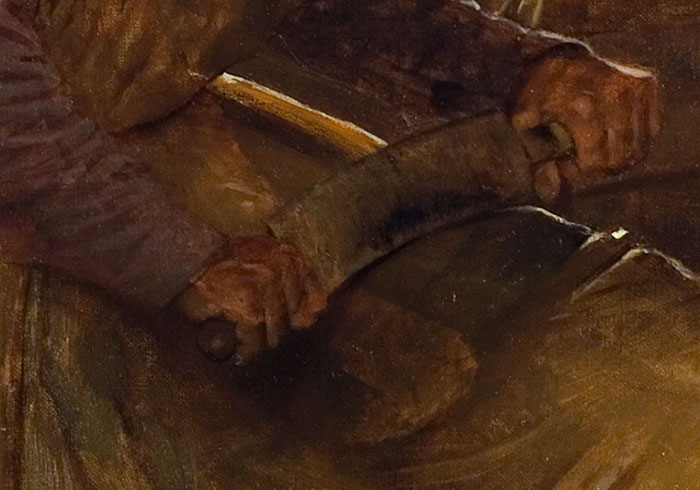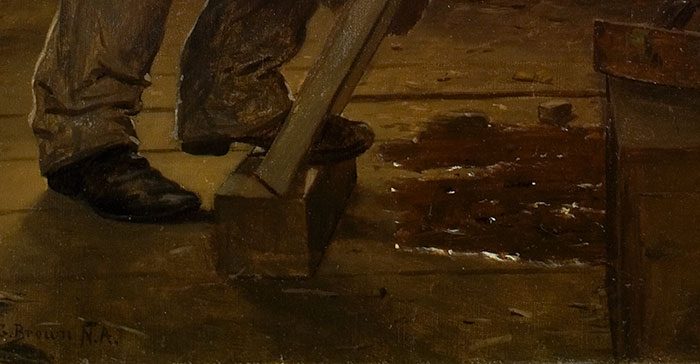Posted on Wed., Aug. 1, 2018 by

John George Brown’s Scraping a Deerskin (also known as Preparing a Deer Hide), 1904, oil on canvas, 30 x 25 in. (76.2 x 63.5 cm.). The Huntington Library, Art Collections, and Botanical Gardens. Purchased with funds from the Art Collectors’ Council and the Virginia Steele Scott Acquisition fund for American Art.
In John George Brown’s Scraping a Deerskin of 1904, sunshine bathes the inside of a toolshed. The light flows from a window that frames a cheery, rural landscape. Yet inside the shed, a rather gruesome scene unfolds. An elderly but strong man trims tissue from a hide that has already been shorn of fat and soaked in water. A puddle from the wet skin glistens at his feet.
Acquired by The Huntington Art Collectors Council in 2008, the canvas currently resides in the Virginia Steele Scott Galleries of American Art. I was initially struck by Brown’s beautiful rendering of a stomach-churning act. The image held another surprise: the scraper is a portrait of the painter himself.
You may be thinking: Most artists depict themselves at some point—where’s the surprise? Well, Brown was hardly a country deer-hunter. Born in England, in 1831, he immigrated to the U.S. at the age of 22, settling in New York City. He first worked in glass factories while painting at night. However, he eventually became both wealthy and famous—not for images of aged, rural folk, but for sensitive (some would say sappy) illustrations of newsboys, flower-sellers, and other poor, urban youth. The melding of the serene and macabre in Scraping led me to a deeper puzzle: If Brown was a life-long city-dweller, beloved for his pictures of children—why did he portray himself, at age 73, shaving a hide in a farm shed?

The image of the man scraping the deerskin is a portrait of the painter himself. Detail of John George Brown’s Scraping a Deerskin (also known as Preparing a Deer Hide), 1904, oil on canvas. The Huntington Library, Art Collections, and Botanical Gardens.
A little research revealed that The Huntington’s canvas was not an anomaly for the artist, but one of the first in a series of paintings, featuring the rural elderly, that he pursued from 1904 until his death. The theme clearly had personal significance. Brown was typically business-minded: he had turned his rascal youths into a formula, producing an average of 25 per year and copyrighting them for mass-consumption in magazines and as prints. His provincial seniors, on the other hand, rarely sold. Yet he continued to paint them. True, the artist was wealthy enough by 1904 that he could afford to ignore market desires. But evidence suggests that his stubbornness was more complex. He told a reporter months before his death: “When J.G. Brown is no more, those who come after me will be rummaging about this studio and they will discover scores of canvases which will show, I hope, that I was not a painter of one idea.” Brown didn’t create Scraping for his contemporaries. Nor strictly for personal pleasure. He was thinking about posterity.
While this explains the artist’s resolve, it doesn’t account for the subject matter. Experts believe Brown was motivated to depict rustic septuagenarians not only to secure his own legacy, but also out of concern for the way the U.S. was changing. The 19th century was a time of industrialization and urbanization throughout the nation. The Ashcan School (also represented in the Scott Galleries), and other American artists, captured the excitement and anxieties of modern life in their pictures. Brown, conversely, sought to preserve the figure of the hunter-farmer-craftsman, whose “self-reliant,” agrarian ways appeared to be headed for extinction.

The hammer and the leg of the workbench form a cross. This shape is echoed by the two beams supporting the hide. John George Brown’s Scraping a Deerskin (also known as Preparing a Deer Hide), 1904, oil on canvas. The Huntington Library, Art Collections, and Botanical Gardens.
However, the symbolism in Scraping indicates that the painter’s goal was not strictly documentary. Brown conflates the morality and mortality of Christ with both the American yeoman and his own work as an aging artist. Look, for example, at the center-right of the image, where the hammer and leg of the workbench form a cross. This shape is echoed by the two beams supporting the hide. The deerskin, in addition to evoking hunting—a mainstay of the pioneer life—is a Christian symbol of the soul’s quest for god. Besides alluding to piety and the crucifixion, Scraping insinuates the act of painting, with the hide, puddle, and smears of white on the workbench and chest recalling Brown’s own tools: canvas, oil, and pigment.
The artist’s technique further communicates his wistful mourning of what he perceived to be a more idyllic, American culture. Only the view outside the window is opaque. Inside the shed, Brown’s thin layering of paint, the subtle halo surrounding his avatar, and his noticeable reworking of the figure’s limbs (most obvious above the man’s right hand) give the picture a ghostly, diaphanous feel—as if the whole thing were a fading apparition.

Brown reworked the figure’s limbs—most obviously above the man’s right hand (the hand on the left side from the viewer’s standpoint)—giving the picture a ghostly, diaphanous feel. Detail of John George Brown’s Scraping a Deerskin (also known as Preparing a Deer Hide), 1904, oil on canvas. The Huntington Library, Art Collections, and Botanical Gardens.
Brown evidently felt no responsibility for the disagreeable social, economic, and environmental changes that, in his opinion, were spoiling the pastoral republic—though he was an urbanite who skillfully interpreted the tastes of fellow New Yorkers, most of whom made their money through the new mechanisms of industrialization. Indeed, the artist adopted these strategies himself, increasing his sales through patenting, mass-production, and investment. In Scraping, however, Brown cast himself as a rural hunter, preserving “traditional” America in his own image—an ironic act considering he was a new arrival to the country.
Art historian Kathleen Placidi has noted that Brown was able to claim this heritage without criticism because he came from Britain, like the predecessors of most New Englanders who made up the art-viewing public of the day. She further observes that, among this public, such nostalgic images as Scraping bolstered convictions that the nation was composed of two groups: those originating from Anglo settlers and embodying “true” American values; and those newly arrived Irish, Italian, Chinese and Eastern-European immigrants—frequently blamed, at the time, for the country’s ills.

A puddle from the wet deerskin glistens at the scraper’s feet. Detail of John George Brown’s Scraping a Deerskin (also known as Preparing a Deer Hide), 1904, oil on canvas. The Huntington Library, Art Collections, and Botanical Gardens.
Brown’s work deserves more than a passing glance—not just for its enthralling combination of the gorgeous and grisly, but for the way it continues to resonate in our own cultural and political moment.
Lily Allen is curatorial assistant of American Art at The Huntington.